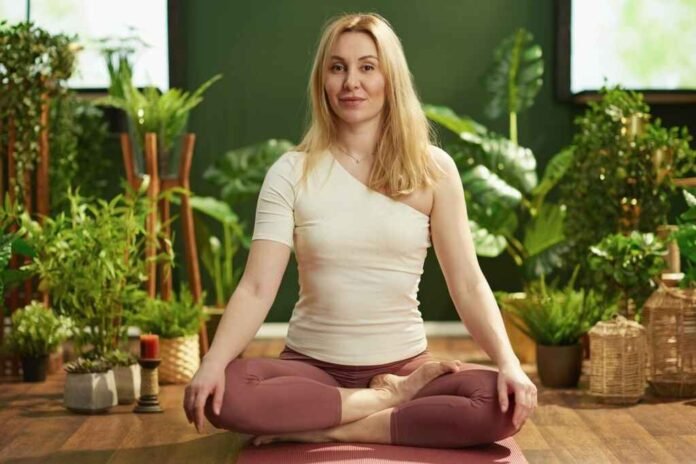1 Person Yoga: In an ultra-modern fast-paced world, locating a second of tranquillity and self-reflection can be hard. The demands of Labor, our family, and our daily lifestyles can leave us feeling overwhelmed and disconnected from ourselves. This is why yoga comes in as a powerful tool for self-care and proper properly-being.
In this complete manual, we will discover the world of one-character yoga, an exercise that permits people to discover stability, peace, and self-discovery on their terms. Whether you are a seasoned yogi or an entire amateur, this newsletter will offer you treasured insights and sensible guidelines to incorporate 1-individual yoga into your day-by-day ordinary.
What is 1 Person Yoga?
1 Person Yoga, additionally called solo yoga or self-practice yoga, is a shape of yoga that permits individuals to work out yoga on their very own, without the guidance of an instructor or the presence of a set. It’s a deeply non-public and introspective exercise that encourages self-recognition and mindfulness. Unlike traditional organization yoga training, 1-individual yoga gives you the liberty to set your pace, select your poses, and tailor your exercise for your specific needs and preferences.
Benefits of one-Person Yoga
Before we delve deeper into the sector of one-individual yoga, permit discover some of the amazing benefits it gives:
- Personalized Experience: One of the most good-sized benefits of one-character yoga is the ability to personalize your exercise to fit your specific goals and frame kind. You have the freedom to be cognizant of the poses and strategies that resonate with you the maximum.
- Flexibility: With solo yoga, you can practice whenever and wherever you like. There’s no need to adhere to a fixed schedule or location, making it ideal for busy individuals.
- Deeper Connection: Solo yoga fosters a deeper connection with yourself. It encourages introspection, self-discovery, and extra expertise of your frame and thoughts.
- Stress Reduction: Yoga, in preference, is understood for its stress-reducing benefits. 1-man or woman yoga allows you to unwind and locate tranquility, decreasing the terrible effects of pressure on your frame and thoughts.
- Improved Focus: Practicing yoga permits me to pay attention absolutely to my breath, movement, and meditation, enhancing my typical attention and concentration.
Getting Started with 1 Person Yoga
Now that you understand the benefits of 1 Person yoga, let’s explore how you can start your solo yoga practice:
1. Find Your Motivation
Begin by reflecting on why you want to practice 1 Person yoga. Is it to reduce stress, increase flexibility, or find inner peace? Identifying your motivation will help you set clear intentions for your practice.
2. Choose Your Yoga Style
Yoga comes in various styles, such as Hatha, Vinyasa, and Ashtanga. Research and attempt one-of-a-kind patterns to determine which one resonates with you the most. Your chosen style will shape your practice.
3. Set Realistic Goals
Set achievable goals for your practice. Whether it’s mastering a specific pose or practicing yoga daily, having clear objectives will keep you motivated and focused.
4. Create a Routine
Establish a regular practice routine. Consistency is key to reaping the benefits of 1 Person yoga. Dedicate a specific time each day or week to your practice.
5. Gather Equipment
You don’t want numerous fancy systems to practice 1-individual yoga, however having a yoga mat, comfortable clothing, and props like blocks and straps can beautify your enjoyment.
For amazing yoga equipment, you may visit LifeMaintain, wherein you may find a huge variety of yoga add-ons to assist your exercise.
Essential Yoga Poses for Solo Practice
Whether you’re a beginner or an experienced yogi, incorporating these essential yoga poses into your solo practice can help you build strength, flexibility, and mindfulness:
1. Downward-Facing Dog (Adho Mukha Svanasana)
- Start in a tabletop position with your wrists under your shoulders and knees under your hips.
- Press into your palms, tuck your toes, and lift your hips toward the ceiling, forming an inverted V shape.
- Engage your core, relax your neck, and hold for several breaths.
2. Child’s Pose (Balasana)
- Kneel on the mat with your big toes touching and knees hip-width apart.
- Sit returned in your heels and amplify your arms ahead, resting your brow on the mat.
- Breathe deeply and release anxiety in your returned and shoulders.
3. Warrior II (Virabhadrasana II)
- Stand with your feet wide aside, with one foot facing ahead and the other perpendicular.
- Bend your front knee to a 90-diploma angle, keeping your back leg straight.
- Extend your arms parallel to the ground, gazing over your front hand.
Creating the Perfect Yoga Space
Your yoga practice space plays a significant role in enhancing your solo yoga experience. Here’s how you can create the perfect environment for your practice:
1. Choose a Quiet Location
Find a quiet and nonviolent location where you won’t be disturbed. This may be a spare room, a nook in your living room, or even a gap for your outside.
2. Declutter the Space
Clear the area of any clutter or distractions. A tidy space promotes mental clarity and focus.
3. Set the Ambiance
Enhance the atmosphere with soothing music, incense, or essential oils. Creating a calming ambiance can deepen your practice.
4. Invest in Comfort
A comfortable yoga mat and suitable clothing are essential for a pleasant practice. Ensure your mat is slip-resistant and provides adequate cushioning.
5. Natural Light
Whenever possible, practice in natural light. It can boost your mood and create a harmonious connection with nature.
1 Person Yoga vs. Group Yoga
While both 1 Person yoga and group yoga offer incredible benefits, they cater to different preferences and needs. Here is a correlation with assistance you conclude which is ideal for you:
1. 1 Person Yoga
- Personalized: Tailored to your preferences and goals.
- Flexible: Practice on your schedule, wherever you like.
- Introspective: Encourages self-reflection and self-awareness.
- Quiet: Ideal for introverts or those who crave solitude.
2. Group Yoga
- Community: Provides a sense of belonging and support.
- Guidance: Instructors offer real-time feedback and adjustments.
- Motivation: Group dynamics can boost motivation and commitment.
- Social Interaction: Opportunity to connect with like-minded individuals.
Ultimately, the choice between 1 Person yoga and group yoga depends on your personality, goals, and lifestyle. Many yoga practitioners enjoy a blend of both, incorporating solo practice into their routine while occasionally attending group classes for variety and community.
Incorporating Meditation and Mindfulness
Meditation and mindfulness are integral components of yoga. Here’s how you can incorporate these practices into your solo yoga sessions:
1. Breath Awareness
Begin your practice with a few minutes of conscious breath awareness. Focus on your inhalations and exhalations, allowing your breath to guide your movements.
2. Guided Meditations
Use guided meditation apps or recordings to deepen your mindfulness practice. These can help you stay present and cantered during your solo yoga session.
3. Silent Meditation
After your physical practice, take a few minutes to sit in silent meditation. Close your eyes, observe your thoughts, and let them pass without attachment.
Common Challenges and Solutions
While 1-individual yoga offers several benefits, it also comes with its share of challenges. Here are some not-unusual barriers and the way to overcome them:
1. Lack of Motivation
Solution: Set clear goals and reminders for your practice. Create a supportive routine that includes rewards for achieving milestones.
2. Distractions
Solution: Minimize distractions by choosing a quiet location and turning off electronic devices. Consider using noise-cancelling headphones if needed.
3. Self-Criticism
Solution: Practice self-compassion and patience. Remember that yoga is a journey, and progress takes time.
4. Plateaus
Solution: Seek inspiration from online resources, books, or workshops to add variety to your practice and overcome plateaus.
Resources for Your 1 Person Yoga Journey
Embarking on a 1-man or woman yoga adventure is an interesting and fulfilling enterprise. Here are some assets to assist your practice:
- Online Yoga Classes: Many structures offer online yoga classes, permitting you to access a wide variety of instructions and instructors from the comfort of your own home.
- Yoga Books: Explore books on yoga philosophy, anatomy, and practice techniques to deepen your understanding of yoga.
- Yoga Apps: Several mobile apps provide guided yoga sessions, meditation exercises, and tracking features to monitor your progress.
- Community Forums: Join online yoga communities or forums to connect with fellow practitioners, share experiences, and seek guidance when needed.
- Yoga Accessories: Visit LifeMaintain for high-quality yoga mats, props, and accessories that can elevate your practice.
Conclusion
1 Person Yoga is an effective practice that empowers individuals to embark on a journey of self-discovery, internal peace, and personal growth. Whether you are in search of a pressure remedy, flexibility, or a deeper reference to yourself, solo yoga offers a route to reaching those dreams in your phrases.
Remember that your 1 Person yoga journey is unique to you. Embrace the freedom, flexibility, and mindfulness it provides, and don’t hesitate to seek guidance or resources when needed. With dedication and consistency, you can unlock the incredible benefits of 1 Person yoga and find balance and peace in your life. Start your solo yoga practice today and experience the transformative power of this ancient practice.

